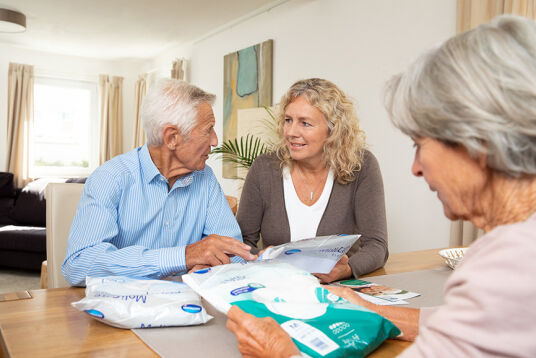Incontinence
What is the difference between incontinence pads and sanitary pads?
by Molicare March 15, 2022

Many women and men affected by incontinence use conventional sanitary towels or panty liners to absorb leaked urine. Reasons for this can be inexperience or reluctance to wear special continence pads. In the case of bladder weakness, special pads for incontinence are the right aids to counter the symptoms safely and discreetly.
Why women and men often use sanitary pads for incontinence?
The use of sanitary napkins during menstruation is familiar to most women - and the products have proven themselves over the years. If a slight bladder weakness suddenly occurs, it makes sense to first consider using normal panty liners in these cases as well. Disguised as shopping for their partner, men affected by incontinence also often use sanitary napkins initially because of shame and ignorance about appropriate incontinence products (1).
At first glance, it seems to make sense to use sanitary towels instead of incontinence pads: for many women it has been a decades-long routine to buy and use panty liners. And men too often find themselves in the situation of buying sanitary towels for their partners. You are already familiar with this product – unlike with incontinence products. In addition, those affected may feel a sense of shame when urinary or faecal incontinence occurs, which is why they shy away from buying appropriate incontinence aids. So, it stands to reason that those affected use feminine hygiene products. But it is important to know that incontinence pads can meet your needs much better than panty liners – and save money in the long term.
Why panty liners are not suitable for incontinence?
At first glance, pads are cheaper than special continence pads. However, they are only intended to absorb menstrual bleeding. This is discharged more slowly and in smaller amounts than urine. In addition, blood is thicker than urine. Conventional panty liners can therefore not absorb the amount of urine and must be changed much more frequently than liners, which have higher absorbency levels than sanitary towels.
HARTMANN specialists explain it as follows: “Sanitary towels can be used with heavy menstruation, but the pads usually only contain cellulose and little superabsorbent polymers (or SAP for short). Since menstrual blood coagulates, it easily sticks to the fibres or pulp of the insert. This is not the case with urine. For example, a sanitary napkin usually does not keep the skin dry and odour can form. This makes sanitary towels very expensive because they quickly stop absorbing liquid and have to be changed 10 or more times a day."
1. Kontinenz, Inkontinenz, Kontinenzförderung, Praxishandbuch für Pflegende, Hayder, Kuno, Müller, Huber Verlag, page 35
More related articles

Alcohol and the impact it has on your bladder and bowels
While you might be familiar with the health detriments that alcohol can have on your heart, kidney and liver, you may not be aware of how it impacts your bladder and your bowels. Drinking alcohol regularly can cause a whole series of illnesses that affect

